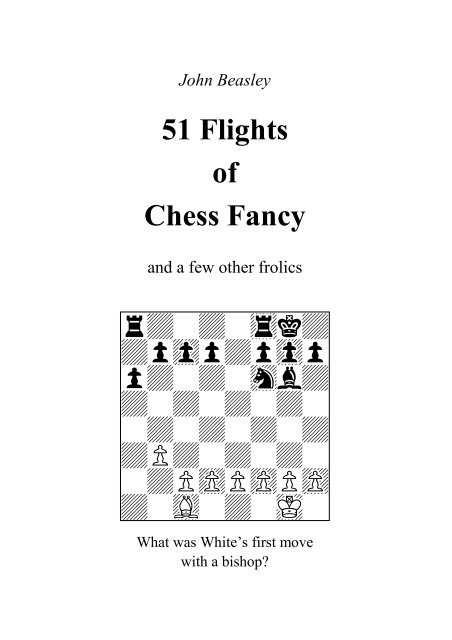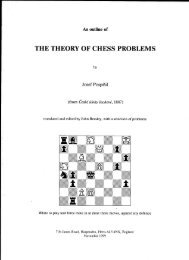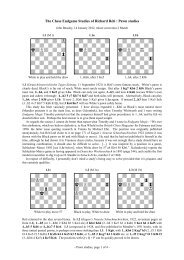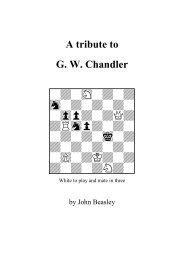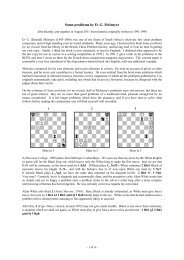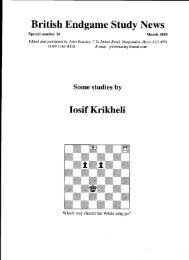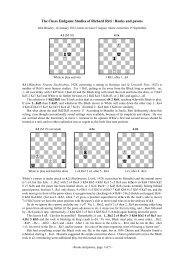Introductory pages - John and Sue Beasley
Introductory pages - John and Sue Beasley
Introductory pages - John and Sue Beasley
You also want an ePaper? Increase the reach of your titles
YUMPU automatically turns print PDFs into web optimized ePapers that Google loves.
<strong>John</strong> <strong>Beasley</strong><br />
51 Flights<br />
of<br />
Chess Fancy<br />
<strong>and</strong> a few other frolics<br />
rdwdw4kd<br />
dp0pdp0p<br />
pdwdwhbd<br />
dwdwdwdw<br />
wdwdwdwd<br />
dPdwdwdw<br />
wdP)P)P)<br />
dwGwdwIw<br />
What was White’s first move<br />
with a bishop?
Contents<br />
Introduction 3<br />
1 Endgame studies 4<br />
2 Creating a study from a game position 25<br />
3 Problems 29<br />
4 Variant forms of chess 33<br />
5 How did we get here ? 41<br />
6 Joke compositions 45<br />
Interlude 53<br />
7 Three knight puzzles 55<br />
8 Three coin puzzles 58<br />
9 Three thirteen-hole pegboard puzzles 59<br />
10 Three bridge frolics 61<br />
Sources <strong>and</strong> technical notes 64<br />
ISBN 978-0-9555168-1-8<br />
Author’s copyright notice. I have no authority to waive any rights that<br />
may be held by others, but in so far as anything in this book is original<br />
with myself it may be quoted or copied without payment or formality;<br />
I ask only that there be due acknowledgement.<br />
Typeset by the author<br />
Originally printed by MediaPRINT Ltd, The Print Cabin,<br />
381 Luton Road, Harpenden, Herts AL5 3NF<br />
Published by the author at 7 St James Road, Harpenden, Herts AL5 4NX<br />
June 2009 (version with minor corrections April 2011)
Introduction<br />
This is the third, <strong>and</strong> will be the last, of my little chess vanity-books.<br />
Some flights of chess fancy (1989) was a typical problem composer’s<br />
vanity-book of the period, <strong>and</strong> contained between a half <strong>and</strong> two thirds of<br />
what I had published up to then. But while the advent of home computers<br />
<strong>and</strong> “desktop publishing” vastly increased the amount that people could<br />
write, there was no corresponding increase in the time they had for<br />
reading, <strong>and</strong> I deliberately restricted More flights of chess fancy (2000)<br />
to the 25 positions that I thought people could work through before<br />
becoming bored. The present book contains slightly more than twice as<br />
many, so I am expecting readers to be selective, but the positions are<br />
grouped by type, <strong>and</strong> the reader who finds a particular chapter not to his<br />
or her taste can easily ab<strong>and</strong>on it <strong>and</strong> move on to the next.<br />
Some flights concentrated on problems, but included a few endgame<br />
studies. More flights contained problems only. The present book gives<br />
precedence to endgame studies, which have been my main interest in<br />
recent years, but it repeats my favourite problems from Some flights <strong>and</strong><br />
More flights with one or two recent additions, <strong>and</strong> there are a few items<br />
from fields other than chess.<br />
In the endgame study chapter, I have put the solutions immediately<br />
below the diagrams, but each new position is always at the top of a<br />
column <strong>and</strong> normally at the top of a new page, <strong>and</strong> the reader who prefers<br />
to solve for himself should find it easy enough to cover the text <strong>and</strong> have<br />
a go before reading on. In the problem chapters, the diagrams appear first<br />
without solution, <strong>and</strong> the solutions appear overleaf below fresh diagrams.<br />
In many cases, particularly in the endgame study chapter, I have added<br />
a few words saying how the position was discovered. Perhaps these brief<br />
descriptions will help to show that chess composition is not the arcane<br />
mystery which it is sometimes thought to be, <strong>and</strong> will tempt readers into<br />
having a go themselves.<br />
I am sometimes asked by a budding composer how many studies or<br />
problems he or she needs to produce for the exercise to be worth while,<br />
<strong>and</strong> my answer is very simple: one good one. Whether anything that<br />
follows meets this criterion is perhaps another matter, but I hope it will at<br />
least raise a passing smile.<br />
Harpenden, Hertfordshire, Engl<strong>and</strong>, June 2009.


